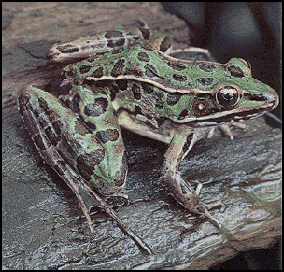
The leopard frog, Rana pipiens

The leopard frog, Rana pipiens
Rana pipiens is a slender greenish to brownish frog with dark spots which are usually edged with a lighter color. It has a light stripe along its upper jaw and tends to grow to be a little over 3 inches in length. As tadpoles and froglets leopard frogs are herbivorous, feeding mostly on algae and other plant matter in their habitat. As mature frogs, these organisms consume large numbers of insects. Throughout their life cycle leopard frogs are not very selective of the foods they eat. Leopard frogs often stray far from water, but they must return to open water to breed. Male leopard frogs identify females by their distinctively plump physique. Males, which are usually smaller in size, use their specialized thumbs to clasp females during mating. Mating occurs in water while the female swims with the male attached to her back. By releasing their eggs, females stimulate milt ejaculation by the male, and the eggs are fertilized. Like most frogs, leopard frogs are sluggish animals, often staying immobile for long periods of time. The characteristic croaking of frogs is used to establish individual territories and attract females. Leopard frogs are found in the marshes, meadows, and ponds in the United States and Canada.
Tree of Life: Rana
The diet of an adult frog consists primarily of insects, which it catches in a rather characteristic way. Frogs will typically sit motionless until a prey comes within striking distance, at which point it will very quickly orient towards the prey and attempt to catch it by extending its tongue and/or snapping its jaws. (See animation).
This provides an ideal system for studying sensorimotor integration, since the behavior is triggered by easily reproducible stimuli, and the relationship between the location of the stimulus and the physical response is well understood. Futhermore, this system easily lends itself to a neuroethological approach, and hence a lot of work has been done investigating the neural mechanisms underlying the prey-capture behavior.
A very simple model of the neural circuitry underlying the behavior is presented in figure 1. Here, input from both the visual (retina) and the tactile (snout, front and hind limbs) senses is topologically mapped into the tectum (left tectal lobe shown in center of figure). From there, connections to the motor neurons drive the actual orienting and snapping behavior.
Figure 1. (Grobstein et al, 1983)

A significantly more sophisticated model of the same neural substrates can be seen in figure 2. Figure 2a shows connections that have been derived from physiological experimental data. Figure 2c shows the anatomically identified connections. Note that in these figures, the pathways for both the predatory-avoidance and the prey-capture are included.
Figure 2. (Ewert et al, 1983)

(Key: AT - anterior dorsal thalamus; CT - caudal dorsal thalamus; OT - optic tectum; T - telencephalic nuclei; EY - eye; HY - hypothalamus; MP - medial pallium; PA - preoptic area; ST - striatum)
Some research has been done in an attempt to actually build a working model of the prey capture behavior - Figure 3 shows the circuitry of one such model. The implemented connections correlate with the anatomical findings as well as lesion data.
Figure 3. (Cobas et al, 1992)

Classic Papers:
Review Articles:
Recent Advances:
This page prepared by:
Dan Foygel, Dec '96
